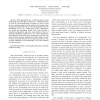115
click to vote
WCRE
2009
IEEE
15 years 7 months ago
2009
IEEE
The increasing amount of data available about software systems poses new challenges for re- and reverse engineering research, as the proposed approaches need to scale. In this con...
130
Voted
WCRE
2009
IEEE
15 years 7 months ago
2009
IEEE
—Object-oriented software quality models usually use metrics of classes and of relationships among classes to assess the quality of systems. However, software quality does not de...
125
click to vote
WCRE
2009
IEEE
15 years 7 months ago
2009
IEEE
Abstract—Enterprise Applications are complex software systems that manipulate much persistent data and interact with the user through a vast and complex user interface. In partic...
94
Voted
WCRE
2009
IEEE
15 years 7 months ago
2009
IEEE
The proposed research defines data fusion approaches to support software maintenance tasks at the feature level. Static, dynamic, and textual sources of information are combined t...
WCRE
2009
IEEE
15 years 7 months ago
2009
IEEE
—Static disassembly is a crucial first step in reverse engineering executable files, and there is a considerable body of work in reverse-engineering of binaries, as well as are...
88
Voted
WCRE
2009
IEEE
15 years 7 months ago
2009
IEEE
—Navigating large software systems is difficult as the various artifacts are distributed in a huge space, while the relationships between different artifacts often remain hidden...
106
click to vote
WCRE
2009
IEEE
15 years 7 months ago
2009
IEEE
Feature models are widely employed in domainspecific software development to specify the domain requirements with commonality and variability. A feature model is usually construct...
108
Voted
WCRE
2009
IEEE
15 years 7 months ago
2009
IEEE
—During the evolution of a software system, a large amount of information, which is not always directly related to the source code, is produced. Several researchers have provided...
117
click to vote
WCRE
2009
IEEE
15 years 7 months ago
2009
IEEE
—Current malware is often transmitted in packed or encrypted form to prevent examination by anti-virus software. To analyze new malware, researchers typically resort to dynamic c...
103
Voted
WCRE
2009
IEEE
15 years 7 months ago
2009
IEEE
—“God class” is a term used to describe a certain type of large classes which “know too much or do too much”. Often a God class (GC) is created by accident as functionali...





